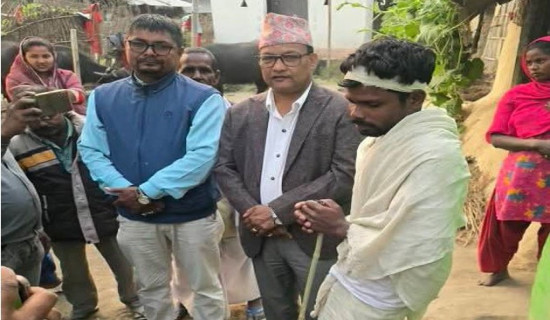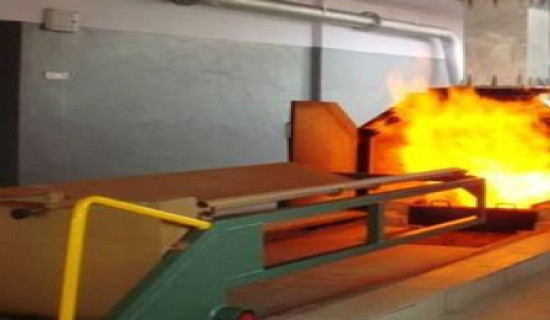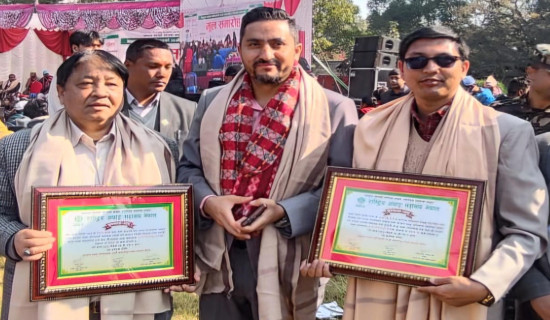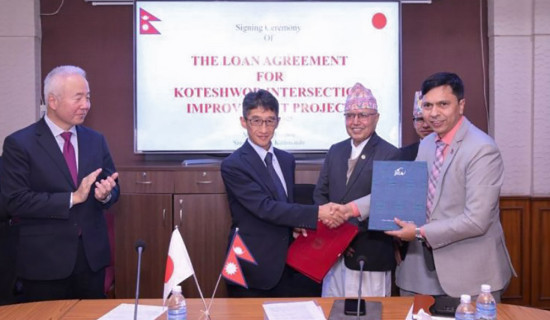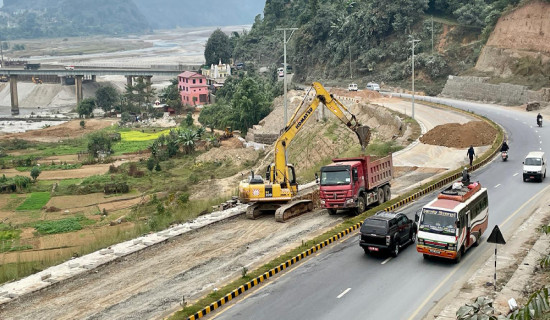- Wednesday, 3 December 2025
Millet Cultivation For Food Security In Nepal
Finger millet (Eleusine coracana) is the main millet crop cultivated in Nepal over 267,071 hectares of farmland, with a production of 339,462 metric tons. Other millets cultivated in Nepal are Proso millet (Panicum miliaceum), which is called Chino; Foxtail millet (Setaria italica); Kaguno; Pearl millet (Penniestum typhoides); Bajara; Sorghum bicolor; and Junelo, of which production statistics are not available. Barnyard millet (Echinochola frumentacea), Sawa, and Kodo millet (Paspalum scrobiculatum) are cultivated in nominal areas and treated as weeds in other large areas.
Millets can be successfully cultivated in Nepal from the Terai to the Himalayan region, up to an altitude range of 3,000 metres above sea level. Proso millet and foxtail millets are of Chinese or Mongolian origin, and finger millet, pearl millet, and sorghum are of African origin, which is regarded as the indigenous crop species of Nepal. There is a lot of local varietal diversity in proso millet, finger millet, and foxtail millet.
Millets are small grains that are highly nutritious for humans. They are naturally glutton-free cereals. Millets contain 7 to 15 per cent protein, depending on the type. Its carbohydrate content is lower than that of rice, wheat, and maize. Millets are a good source of minerals, vitamins, and dietary fibre and are thus regarded as a superfood. They have a low glycemic index, which is helpful in managing blood sugar levels. We can get nutritional and health benefits from millets. Millets have antioxidant properties that help with heart health, body weight maintenance, gut health, bone health, and reducing the risk of certain cancers.
Millets can serve as a dietary staple food, providing a significant portion of the daily caloric intake. Many food products are prepared from millets according to the taste and cultural importance of the place. Millets can be cooked like rice in porridge, soups, and stews. They make high-quality baby food. Millet grains can be ground into flour to make bread, pancakes, sel roti, and many other salty and sweet snack items. Tin pane, our famous traditional alcoholic beverage, is also made from millets. Millets can also be brewed to make beer and other beverages.
Millets have an important place in the farming systems of Nepal. They are drought-tolerant, hardy crops that can be successfully cultivated in different agroecological zones of the country. Sorghum and pearl millet can be grown in hot and dry areas. Proso millet and foxtail millet can be cultivated in highland areas. Finger millet can be cultivated everywhere. The water requirement is very low in millet cultivation compared to rice. Millets require 70% less water than rice and do not disturb soil health like rice. Water stagnation in the field kills a lot of soil flora and fauna useful in crop production. All the residual plant materials from millets after harvesting seeds can be used as fodder for livestock. Millets and grains are also good sources of animal and bird feed. Millet biomass can be used in mulching, composting, thatching, and making handicrafts. The below-ground biomass of the root systems of the millets is very good for maintaining good soil health.
Millets are very important for food insecurity. The skyrocketing food import situation in the country indicates future food insecurity. Nepal must seek self-sustaining food systems for prosperity. Promotion of millets can bring food self-sufficiency to the country. Millets can be successfully cultivated in rain-fed conditions in Nepal, as rainwater is sufficient for their growth and development. Millets are a short-duration crop and can be cultivated as a catch crop if other main crops fail. They require less production input and less tillage. They can be cultivated in a cost-effective way. Millets are nutrient-dense and can reduce malnutrition rates.
Policy recognition and priority are urgently needed for millet promotion. Traditionally, millets were the minor underutilised crop species, which are not fully recognised by the government and donor groups. Research and development of millets are very weak. Now, millet cultivation is gaining popularity internationally due to its suitability in the context of climate change. Nepal being one of the most vulnerable countries to climate change, millets can be cultivated here as climate-resilient crops. They have a very low carbon footprint. They are good for nutritional value, soil health, and significantly reducing greenhouse gas emissions. They have a great role in climate change mitigation and adaptation.
Millets can contribute to achieving several sustainable development goals, like zero hunger (SDG 2), good health and wellbeing (SDG 3), clean water and sanitation (SDG 6), decent work and economic growth (SDG 8), responsible consumption and production (SDG 12), and climate action (SDG 13). By realising this, the UN and FAO celebrated 2023 as a millets year to create awareness about millets and promote them globally for food security. India is giving high priority to millet cultivation. The Consultative Group on International Agriculture Research (CGIAR) under the UN is redirecting its resources towards millet research and development.
The International Crop Research Institute on Semi-Arid Tropics (ICRISAT) is mandated to do research and development on millets globally. This organisation is developing millet production and processing technologies for the poor nations of the world. Nepal has free access to varieties and technologies developed by ICRISAT. The National Hill Crops Research Programme (NHCRP) and the Nepal Agriculture Research Council (NARC) are responsible for doing research on millets in Nepal. The Hill Crops Research Programme is located in Kavre, Dolakha district. The programme coordinates with ICRISAT to bring technologies and seed varieties from ICRISAT. ICRISAT also provides training to NARC scientists and extension personnel about millets and legumes research and development. NARC is responsible for developing technologies, and the Department of Agriculture is responsible for disseminating technologies to producers and farmers.
Farmers can get technologies for millet production from NARC, ICRISAT, private companies, and agriculture service providers to enhance production and profitability. To maximise yield per unit area and minimise environmental impacts, farmers need to adopt suitable technologies according to the local microclimatic conditions. Millet species and varietal selection, conservation tillage, moisture management, agro-ecological practices, integrated pest management, erosion control, resource-efficient practices, waste reduction and circularity, and education and training for farmers are some of the important technologies and activities for millet cultivation. Researchers need to come up with climate-smart millet production technologies.
A market guarantee is a great incentive for millet producers. The market demand for millets is increasing day by day due to their tremendous health benefits and public awareness. There has been a high demand for millets among health-conscious urban consumers in recent years. The nearest market is the most reliable for the powerless small producers and also for the poor consumers. Therefore, strengthening the existing value chain and developing local new value chains in millets is urgently needed to take advantage of millet farming in the country. Local food banks and local seed banks have also played a great role in local value chain development. Farmer training and community support are also crucial. The government should develop minimum infrastructure for value chain development, like processing facilities, product diversification, quality standards, value addition, transport, and security situations. Local millet production, processing, and product diversification activities should be linked with agro-tourism and with urban and rural market centres.
Millet production is a sustainable and versatile agriculture practice that can simultaneously address multiple challenges, including food security, climate change mitigation, and rural economic development. Millets, by nature, are climate resilient and are successful in increasing food production in areas of our country where there is frequent crop failure due to drought.
Millets are a nutrient-rich food source, and they help combat malnutrition and improve food security in remote rural areas. They are very suitable for crop rotation and local cropping patterns, and they are good for atmospheric carbon sequestration into the soil through their root systems. Rural income generation is possible through millet farming, processing, value addition, and product diversification.
The cultivation of millets has high potential for Nepal. Their production should be increased in the country for food import substitution and local economic prosperity. Therefore, the government should prioritise millet research and implement promotional activities in all districts of the country. Then there will be successful participation from family farms, agribusinesses, processors, and other value chain actors for millet cultivation, processing, and marketing.
(The author is a senior agricultural scientist who worked at the Agricultural Research Council-NARC.)



